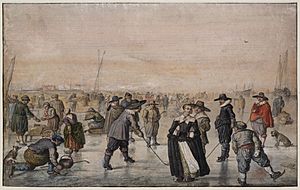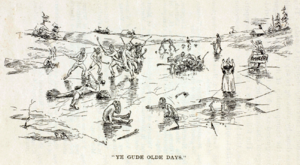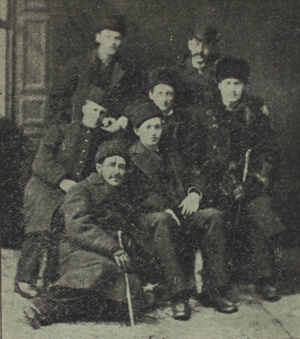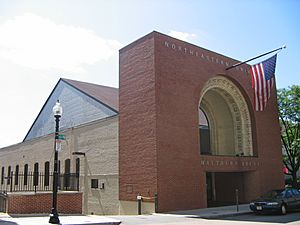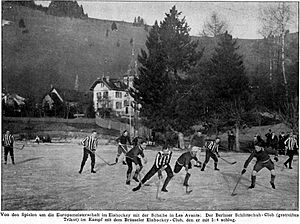History of ice hockey facts for kids
Ice hockey is a super exciting sport played on ice with skates, sticks, and a puck! It grew from older stick-and-ball games played in Europe, like bandy, hurling, and shinty. The North American game of lacrosse also played a part. When these games came to North America, people started playing similar winter games on ice, like shinny. Eventually, these fun, informal games turned into the organized sport we know today as ice hockey, with clear rules.
Contents
What's in a Name?
In England, the game of field hockey was often just called 'hockey'. The word 'hockey' first appeared in print in 1772.
Early Stick-and-Ball Games
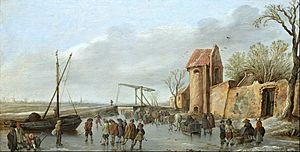
Games played with sticks and balls are very old! For example, polo was played in ancient Persia (now Iran). In Europe, games like Irish hurling, Scottish shinty, and different kinds of field hockey (like bandy ball in England) were popular.
A game called IJscolf, which was like colf but played on ice, was popular in the Netherlands during the 1600s. Players used a curved wooden stick and a wooden or leather ball. The goal was to hit a certain point using the fewest tries. A similar game, knattleikr, was played by people in Scandinavia for over a thousand years.
Some people even played "hockey on ice" using a bung (a cork or wood stopper from a barrel) instead of a ball. In 1799, William Pierre Le Cocq described a game of Hockey played with a stick and a bung. An old picture from 1797 shows someone on skates with a stick and a bung on the River Thames in England.
British soldiers and people moving to Canada and the United States brought their stick-and-ball games with them. They played these games on the frozen lakes and rivers during winter.
To keep from being bored and to stay fit, European soldiers in North America played on frozen rivers and lakes. The British played bandy, the Scots played shinty and golf, and the Irish played hurling. Each group learned from the others. Some even tried playing on skates. All these ideas helped create the game that became hockey. Hockey was invented by all these people and cultures working together.
In 1825, explorer John Franklin wrote about playing "hockey on the ice" on Great Bear Lake in Canada. A painting from the 1830s shows people playing a stick-on-ice sport in New Brunswick, Canada. In 1843, a British officer in Kingston, Ontario, wrote about having "great fun at hockey on the ice."
Mi'kmaq Influence
The Mi'kmaq, a First Nations people from Eastern Canada, also had their own stick-and-ball games. Their stories describe a game called tooadijik. They also played a game called oochamkunutk on the ice. The Mi'kmaq even carved some of the earliest ice hockey sticks, which were used by the British for their games.
Early paintings from the 1800s show "shinny," an early form of hockey without strict rules, played in Nova Scotia. Shinny was played on the St. Lawrence River in cities like Montreal and Quebec City. Even today, "shinny" is a popular Canadian word for an informal game of hockey, whether on ice or in the street.
Some historians believe modern hockey started in Windsor, Nova Scotia, based on an old book from 1844 that mentions "hurly on the long pond on the ice." However, the word "hockey" was used for stick-and-ball games as early as 1773, long before these claims.
How Modern Hockey Developed
The city of Montreal, Quebec, Canada, is known as the birthplace of organized ice hockey. On March 3, 1875, the first organized indoor game was played at Montreal's Victoria Skating Rink. Two teams of nine players each competed. Instead of a ball, they used a "flat circular piece of wood" (a puck!) to keep it from flying out of the rink.
Early games could be quite rough!
Shins and heads were battered, benches smashed and the lady spectators fled in confusion.
In 1876, games in Montreal started using rules from England's field hockey organization. In 1877, The Gazette newspaper published seven rules for ice hockey. The McGill University Hockey Club, the first ice hockey club, was founded in 1877.
In 1880, the number of players on each team was reduced from nine to seven.
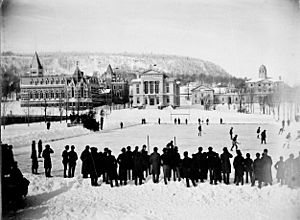
As more teams formed, the first "world championship" for ice hockey was held at Montreal's annual Winter Carnival in 1883. The McGill team won the tournament. The game was divided into two thirty-minute halves. Player positions now had names like left and right wing, centre, rover, point and cover-point, and goaltender.
In 1886, teams at the Winter Carnival created the Amateur Hockey Association of Canada (AHAC). They played a season where teams challenged the current champion.
In 1888, the Governor General of Canada, Lord Stanley of Preston, watched the Montreal Winter Carnival tournament. He was very impressed! His sons and daughter, Isobel Stanley, loved hockey. In 1892, Lord Stanley bought a silver bowl to be a trophy for the best team in Canada. This trophy, first awarded in 1893, became known as the Stanley Cup. It is still awarded every year to the champion team of the National Hockey League. Lord Stanley's daughter, Isobel, was also one of the first women to play ice hockey.
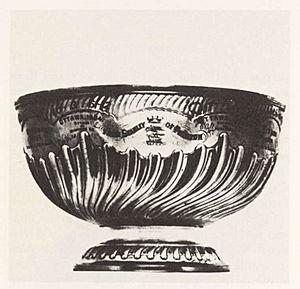
By 1893, there were almost 100 teams in Montreal alone, and leagues all over Canada. Hockey players in Winnipeg started using cricket pads to protect the goaltender's legs. They also introduced the "scoop" shot, now called the wrist shot. William Fairbrother from Ontario is credited with inventing the ice hockey net in the 1890s. Goal nets became standard in Canadian hockey leagues by 1900.
In the United States, Malcolm Greene Chace is known as the "father of hockey." In 1892, he put together a team of players from top universities like Yale and Harvard. They toured Canada, playing games. The first college hockey game in the US was played between Yale and Johns Hopkins in 1893. In 1896, the first ice hockey league in the US was formed in New York City.
Lord Stanley's five sons helped bring ice hockey to Europe. They even played a game at Buckingham Palace in 1895! By 1903, a five-team league was formed in Europe. The Ligue Internationale de Hockey sur Glace (International Ice Hockey League) was founded in 1908 to manage international games. Great Britain won the first European championship in 1910. The sport grew even more in Europe in the 1920s after ice hockey became an Olympic sport. Many bandy players switched to hockey to compete in the Olympics. This league later became the International Ice Hockey Federation.
Many early indoor ice rinks were made of wood and were destroyed by fire. The Matthews Arena in Boston, built in 1910, is the oldest indoor ice hockey arena still used today. It was the first home rink for the Boston Bruins professional team, which started playing in the NHL in 1924.
The Professional Era
At first, hockey was an amateur sport, meaning players were not paid. If players were caught taking money, they were banned. But by 1902, the Western Pennsylvania Hockey League (WPHL) started paying players. In 1904, the first fully professional league, the International Professional Hockey League (IPHL), was formed. This league hired players from Canada, which led Canadian leagues to start paying their players too.
In 1910, the National Hockey Association (NHA) was formed in Montreal. The NHA made important rule changes: they removed the rover position, divided the game into three 20-minute periods, and introduced minor and major penalties. In 1917, the NHA became the National Hockey League (NHL). The NHL expanded into the United States, with the Boston Bruins joining in 1924.
Professional hockey leagues also developed later in Europe. Today, many countries in Europe have professional leagues. Some of the top European leagues include the Kontinental Hockey League, the Czech Extraliga, the Finnish SM-liiga, and the Swedish Hockey League.


